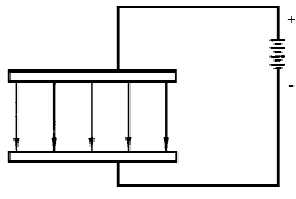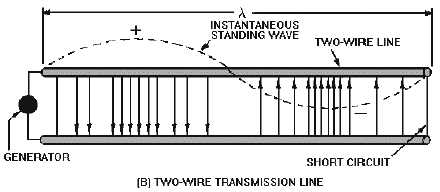1-10
Q-11. The frequency range of a waveguide is determined by what dimensison?
Q-12. What happens to the bus bar dimensions of the waveguide when the frequency is increased?
Q-13. When the frequency is decreased so that two quarter-wavelengths are longer than the "a" (wide)
dimension of the waveguide, what will happen?
Energy Propagation in Waveguides
Since energy is transferred through waveguides by electromagnetic fields, you need a basic
understanding of field theory. Both magnetic (H FIELD) and electric field (E FIELD) are present in
waveguides, and the interaction of these fields causes energy to travel through the waveguide. This action
is best understood by first looking at the properties of the two individual fields.
E FIELD.—An electric field exists when a difference of potential causes a stress in the dielectric
between two points. The simplest electric field is one that forms between the plates of a capacitor when
one plate is made positive compared to the other, as shown in figure 1-11A. The stress created in the
dielectric is an electric field.
Electric fields are represented by arrows that point from the positive toward the negative potential.
The number of arrows shows the relative strength of the field. In figure 1-11A, for example, evenly
spaced arrows indicate the field is evenly distributed. For ease of explanation, the electric field is
abbreviated E field, and the lines of stress are called E lines.
Figure 1-11A.—Simple electric fields. CAPACITOR.
Figure 1-11B—Simple electric fields. TWO-WIRE TRANSMISSION LINE.



